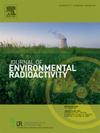Height and terrain correction of UAV radioactive measurements based on DEM data
IF 1.9
3区 环境科学与生态学
Q3 ENVIRONMENTAL SCIENCES
引用次数: 0
Abstract
In this study, we explore the application of unmanned aerial vehicle (UAV) gamma spectrometry in terrestrial radiometric surveys, with a particular focus on the impact of UAV flight altitudes and rough terrain on measurement. Through field experiments conducted at a rare earth deposit in Sichuan, China, radioactive data were obtained from 509 UAV survey points and 585 ground measurement points. A physical model for measuring ground radioactivity using UAVs is established, and the digital elevation model (DEM) in the survey area is used to correct the height and terrain of radioactivity at the measurement points. By qualitatively and quantitatively analyzing the differences between UAV and ground measurement systems in height and terrain, it concludes that the use of height and terrain correction method can utilize UAV measurement data to indicate ground air absorption dose rates, and the indication of corrected UAV-measured data is enhanced as the correction range expands. The results of this study not only confirm the effectiveness of UAV measurement technology in radiometric surveys, but also provide a new method for radiometric surveys under large-scale and complex terrain conditions, which has significant practical application value in fields such as environmental monitoring, resource exploration, and nuclear security.
基于DEM的无人机辐射测量高度和地形校正
在本研究中,我们探讨了无人机伽马能谱测量法在陆地辐射测量中的应用,尤其关注无人机飞行高度和崎岖地形对测量的影响。通过在中国四川的一个稀土矿进行实地实验,从 509 个无人机测量点和 585 个地面测量点获得了放射性数据。建立了利用无人机测量地面放射性的物理模型,并利用测量区域的数字高程模型(DEM)对测量点的放射性高度和地形进行了校正。通过定性和定量分析无人机和地面测量系统在高度和地形方面的差异,得出结论:使用高度和地形校正方法可以利用无人机测量数据来指示地面空气吸收剂量率,而且随着校正范围的扩大,校正后的无人机测量数据的指示效果也会增强。该研究结果不仅证实了无人机测量技术在辐射测量中的有效性,也为大范围、复杂地形条件下的辐射测量提供了一种新方法,在环境监测、资源勘探、核安全等领域具有重要的实际应用价值。
本文章由计算机程序翻译,如有差异,请以英文原文为准。
求助全文
约1分钟内获得全文
求助全文
来源期刊

Journal of environmental radioactivity
环境科学-环境科学
CiteScore
4.70
自引率
13.00%
发文量
209
审稿时长
73 days
期刊介绍:
The Journal of Environmental Radioactivity provides a coherent international forum for publication of original research or review papers on any aspect of the occurrence of radioactivity in natural systems.
Relevant subject areas range from applications of environmental radionuclides as mechanistic or timescale tracers of natural processes to assessments of the radioecological or radiological effects of ambient radioactivity. Papers deal with naturally occurring nuclides or with those created and released by man through nuclear weapons manufacture and testing, energy production, fuel-cycle technology, etc. Reports on radioactivity in the oceans, sediments, rivers, lakes, groundwaters, soils, atmosphere and all divisions of the biosphere are welcomed, but these should not simply be of a monitoring nature unless the data are particularly innovative.
 求助内容:
求助内容: 应助结果提醒方式:
应助结果提醒方式:


